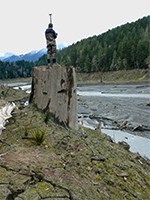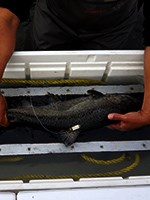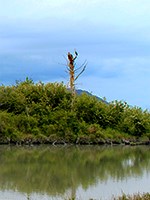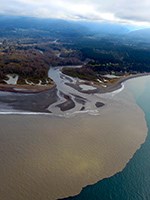
NPS photo Overview The Elwha project, including dam removal, restoration efforts, and protection measures, is serving as a “living laboratory” for monitoring large-scale ecosystem recovery and investigating particular ecosystem processes and components.The project provides a rare opportunity for scientists to learn what happens when a dam is removed and salmon return to a wild, protected river. Among the researchers are fish and marine biologists, botonists, entomologists, geologists, ornithologists, and students. Scientific monitoring and analysis for the project is led by the U.S. Geological Survey (USGS), in coordination with the Olympic National Park, Lower Elwha Klallam Tribe, the Bureau of Reclamation, Washington Department of Fish and Wildlife, U.S. Fish and Wildlife Service, the Environmental Protection Agency, the National Oceanic and Atmospheric Administration, and other local and state entities. River Dam Removal – Rebirth of a RiverThis four-page USGS Fact Sheet describes the river restoration project and USGS science and monitoring. Areas of Study

NPS photo The Elwha River basin covers over 300 square miles (833 square kilometers), transporting freshwater and sediment from the Olympic Mountains to the Strait of Juan de Fuca. Prior to dam removal, most of the river's natural sediment flow was trapped in reservoirs behind the dams. As the dams came down, over 100 years of accumulated sediment was released downstream, causing elevated water turbidity, changes to the channel shape, and modifications to river habitats. Efforts to track the effects of dam removal on the river include monitoring and analyses of river water and sediment discharge, channel morphology, floodplain vegetation, and river geochemistry and nutrients. Learn more about ongoing river studies at the USGS website. 
NPS Photo/R. McKenna The Elwha River was once one of the most productive salmon streams in the Pacific Northwest, home to all five species of Pacific salmon, as well as at least eleven other fish species.When the Elwha and Glines Canyon dams were constructed on the river in the early 1900s, salmon migration into Olympic National Park was blocked and their habitat was reduced to five miles (8 km) of river downstream of Elwha Dam.
Removal of the dams has restored access to over 70 miles of mainstem and tributary habitat. Using research methods such as snorkel surveys, radio telemetry and sonar imagery, biologist are monitoring how salmon are recolonizing the river.

Photo by Ken & Mary Campbell (c) Other Wildlife
Removal of the dams on Elwha River offers an opportunity to investigate these salmon-wildlife interactions. Prior to dam removal, the USGS, National Park Service, and Lower Elwha Klallam Tribe conducted baseline studies of wildlife distribution and species diversity patterns. These studies are providing a comparative baseline to evaluate the long-term effects of dam removal and watershed restoration on wildlife resources in the Elwha River ecosystem. 
NPS photo Elwha River Estuary Learn more about Elwha River estuary research on the USGS website. 
Photo by Tom Roorda (c) Coastal Habitat Learn more about coastal research on the USGS website. |
Last updated: August 9, 2016
